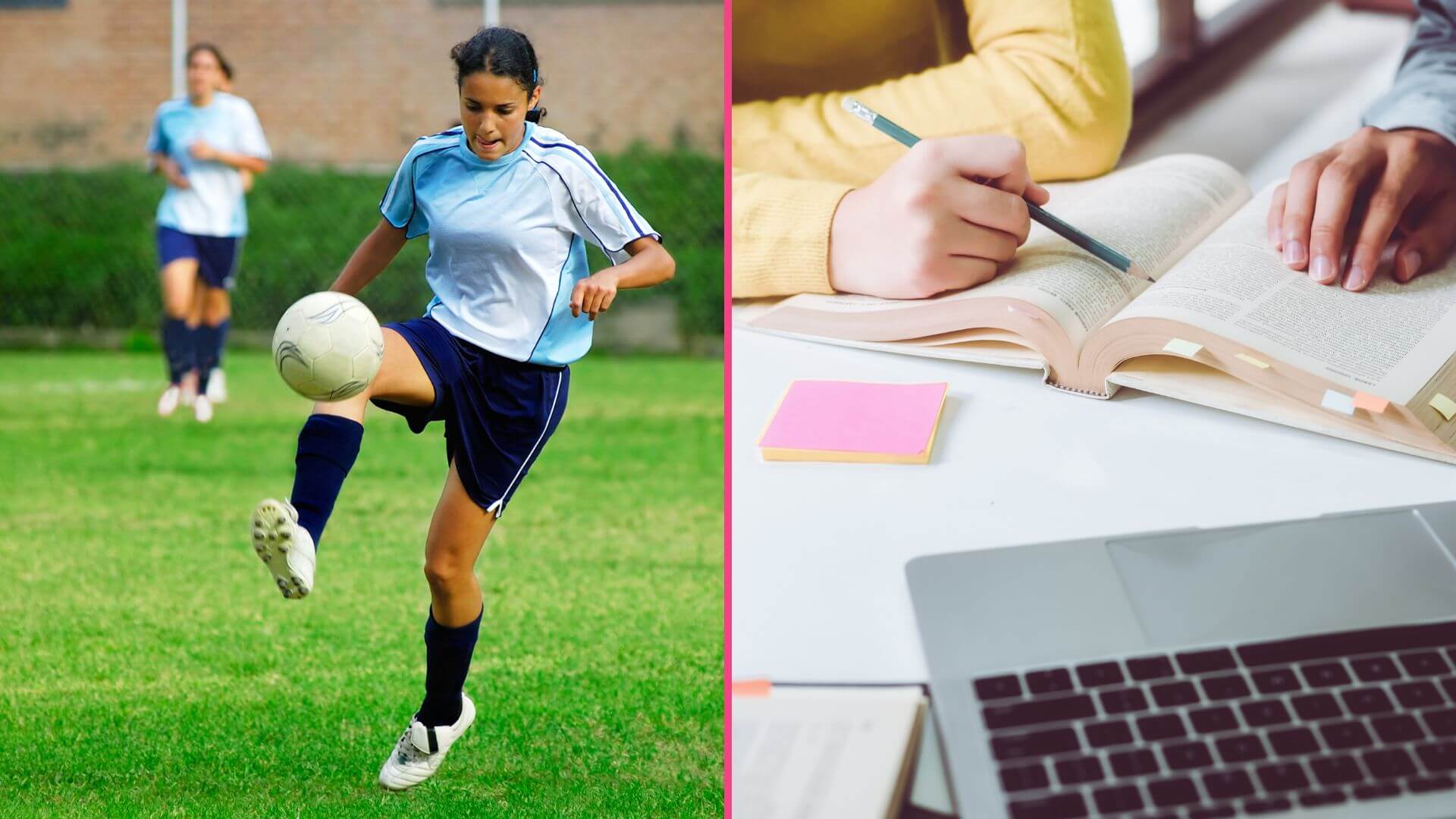Off-Season Soccer Speed and Conditioning for Girls Soccer Players
Summer off-season soccer training is the time to become fast, explosive, and strong.
When games and practices come to an end, it’s an excellent opportunity for girls to implement a performance training plan. This must encompass everything that keeps female athletes healthy and turns them into fast, explosive, and strong players.
This plan must also apply sound training principles. It shouldn’t be a random cacophony of workouts where players just wing it with sets, reps, and work to rest times. Instead, it must be a plan that makes sense, be diligently thought out, and be executed so players don’t risk over-training. Plus, it must have an appropriate progression so they’re at their best and freshest for preseason!
This blog will address non-negotiables for off-season training for girls’ soccer players. Let’s first start with the main training pieces that need to be within this plan.
Off-Season Training Menu
The four areas that need to be the focus for girls’ soccer players in the off-season are strength, deceleration, speed, and conditioning.
1. Strength
Girls must strength train for several reasons. Having strong muscles is protection. If girls are weak, then the high forces from the game go to the bones, joints, and ligaments. Strength allows their bodies to handle the rigorous demands of sprinting, changing direction, jumping, and landing so they don’t tear a knee or roll an ankle.
According to Tim Hewett, Ph.D., one of the top ACL researchers with over 200 publications, strength training reduces ACL injuries by over 60%. Strength must be a non-negotiable part of every soccer girl’s training regimen.
Beyond the injury reduction component, strength helps to build muscle mass to have more horsepower for high-speed running. It improves acceleration and max velocity, two crucial components deciding wins in soccer. The fastest players beat opponents to the ball, gain possession, and score. Girls can’t go wrong with getting strong.
Some of my favorite strength exercises for soccer players hit each major muscle group. For the quadriceps, I’m a huge fan of unilateral movements such as split squats, lunges, and pistol squats.
For the hamstrings, I love RDLs, hamstring curl variations, and good mornings. We mainly do unilateral movements, meaning on one leg, but if we do bilateral, we do Hex Bar deadlifts to load the hamstrings more.
The upper body needs love, too, because it improves posture, lean muscle mass, as well as control of the lower extremity. Pull-ups are one of the best upper-body movements a soccer girl can do. Mind you, they’re downright empowering! Pull-ups work the core as well. A strong and stable core makes it less likely for the knees to be unstable and for a girl to lose her balance.
My favorite core movements include exercises that work on intermuscular coordination of multiple muscle groups (because the core is more than the abs!). The core is the low back, the hips, the obliques, and the entire area that wraps the torso.
Planks, side planks, bear crawls, crab walks, and Copenhagens are some of my go-to’s.
Sit-ups are obsolete at this point, and they’re not the best for soccer players. Not to mention, a high volume of sit-ups can take their toll on the spine and cause backaches later in life. Scrap the sit-ups and start to train for function and good health.
2. Deceleration
Injuries occur due to a lack of deceleration or the ability to pump the brakes and control the body’s momentum. This happens from a lack of eccentric strength (when muscles lengthen). If you know someone who has torn an ACL, they probably told you it happened during a quick cut. That’s deceleration in a nutshell.
To train it, girls need to work on their motor control during single-leg plyometrics.
Single-leg broad jumps, lateral jumps, bounds, and depth jumps are my favorite deceleration exercises. The focus should be crisp landings with the knee softly bent and the hips piked back so the hamstrings fire and stabilize the knee.
Taking the conversation back to core stability–it is critical for proper deceleration. If the core is flimsy, weak, and sways side to side during a braking movement, the entire body loses balance, and the load placed on the knee is far greater. Knee valgus torque will be much higher if the core is unable to stabilize.
This is why I continue to shout to the rooftops, “stop doing sit-ups!” because it does not train proper core stability. Yes, you may get six-pack abs but don’t confuse good aesthetics with proper function to handle game demands.
To take deceleration to the next level, agility drills that are spontaneous and not over-coached will help immensely. This is because the brain needs to be trained under unpredictable environments in conjunction with controlled deceleration training. Cognition must be sharp; otherwise, a slow reaction time can cause lower body mechanics that lead to injury.
I’m no longer a fan of formal drills that tell the athlete how to position their body when decelerating. I’d rather have them play a game of tag, mirror an opponent, or do some sort of reactive or chase drill in a competitive setting.
3. Speed
Most soccer players train speed wrong. If they’re not timing their sprints, performing a max effort sprint for less than six seconds, and resting for three to five minutes in between efforts, they’re NOT speed training.
Speed training requires athletes to perform an all-out linear sprint (over 30 yards distance), timed and tracked, and then plenty of recovery to replenish lost ATP–the main energy source for sprinting. When rest times aren’t long enough, players make a speed drill, a conditioning drill.
Speed must be trained separately, preferably at the beginning of the workout, as the first thing everyone does. This is because athletes need to be totally fresh to train the Central Nervous System to improve speed outputs. Never do a speed workout after a skills session, lift, or game. The nervous system will be too fried at that point.
Speed sessions must be electrical–max outputs of less than six seconds, with a lot of standing around. The focus should be on jumps, mechanics, and sprints. Here are some drills to go all out on:
Keep in mind all sprints must be timed; otherwise, how will you know if you’re getting fast? I like to use the Freelap timing system because it is the gold standard in the speed and track community. It’s well worth the investment because it’s accurate, but it also motivates my girls to go fast and compete (you can get one HERE).
Speed will never improve if it is not tracked. I truly believe players who know what their numbers are become more motivated to improve. It’s human nature.
4. Conditioning
Let me get this out of the way first: stop jogging miles around the track. This is one giant “miss” in the soccer community and is sadly still going on. Soccer-specific conditioning is far, far from long-distance runs, and often, soccer players fill the aerobic bucket enough with playing year-round. They spend plenty of time doing light to moderate cardiovascular work.
Conditioning for the game must be more transferable, meaning players perform explosive efforts for 10-12 seconds in duration, then rest anywhere from 30-90 seconds. In this case, I love tempo runs that cover 60-80 yards in distance so players can work on clean sprinting mechanics (so they get FASTER from conditioning) while also getting a higher heart rate effect.
To progress conditioning, you either increase volume (# of sprints) or, in the final phase of the off-season, you decrease rest time in between efforts. Small-sided games and playing pick-up soccer (4v4s or 6v6s) are excellent forms of conditioning that bring in agility and the cognitive component. These are great to sprinkle into the off-season plan a few weeks out from the preseason.
Sample Off-Season Schedule
So how do we combine all these pieces in a schedule and progression that makes sense?
I like to train four times a week in the off-season. When I tell parents this, some reply, “wow, that’s a big commitment!” Yes, it is because physical adaptations take time and consistency. We can’t do a smart progression if we don’t take our time. If we rush an off-season plan, we are limited on how much we raise our strength, speed, and conditioning ceilings. Mind you, we also risk overtraining by training to bunch too much load in a short period of time.
Sure, players can squeak by with two days a week, and I would say that is an absolute minimum to truly improve. One time a week is useless in the off-season and not enough frequency to provide an adaptation to the body. Think about it: soccer coaches don’t hold practice once a week. Most train two to four days a week because the body needs repetition and progression to improve.
With that said, here is a sample template at the micro level:
Monday – Speed and Conditioning
Tuesday – Total Body Strength
Wednesday – Speed and Conditioning
Thursday – Total Body Strength
Friday – Sun OFF
The Monday through Thursday template has worked best for my girls because they’re able to get in quality workouts during the week, then they have three days of recovery.
A lot of soccer players are under-recovered, and they think they have to plow through the entire week to get a leg up. The truth is recovery is where the gains happen. After a workout, the muscles are in a catabolic state, meaning they’re in breakdown mode and have mini injuries called “micro traumas.” For repair to happen, the muscles need a break from loading.
Additionally, they need replenishment with plenty of protein (20-30 grams a meal!) Most girls don’t get enough protein. Their game would change tremendously if they ate twice as much of it as they’re currently eating. I highly recommend looking at one of my favorite female medical doctors on this topic, Dr. Gabrielle Lyon, for more.
Nutrition is a big part of recovery, so be extra diligent with it in the off-season after workouts.
Here is an off-season template at the macro level:
Month 1 – general focus, more linear run conditioning with minimal decelerations, build aerobic capacity, increase volume each week (reps go up for strength, reps go up for conditioning)
Month 2 – sport specific, more change of direction conditioning (shuttle runs), build speed, increase intensity each week (reps go down for strength, rest times go down for conditioning)
Now that you have an idea of how to implement an off-season program, it’s time to get after it. I am sure you will come out of the summer stronger, more conditioned, and more explosive than ever before. It takes commitment, but it’s so worth it. Please comment below or shoot me a message and let me know how you do.
More Resources
Join Erica’s amazing community of strong female soccer players in her signature online training program, SPEED QUEENS.
For more on female athlete-specific needs like training, nutrition, and menstrual cycle considerations, get her book, THE STRONG FEMALE ATHLETE
ABOUT THE AUTHOR
Erica Suter is a former college All-American soccer player from Johns Hopkins University. She is giving back to the game and to female soccer players as a full-time performance coach. She helps girls with speed, agility, strength, and conditioning development and has been training girls for over 12 years in the ECNL, GA, and NPL.
Her players have gone on to play college soccer at UNC, University of MD, Pittsburgh, Towson University, University of Charleston, MIT, Johns Hopkins, Carnegie Mellon, Rutgers, and more.
Follow Erica on Twitter: @fitsoccerqueen
Check out her podcast: The Soccer Queens Podcast
_
GIRLS SOCCER NETWORK: YOUR SOURCE FOR GIRLS SOCCER NEWS













